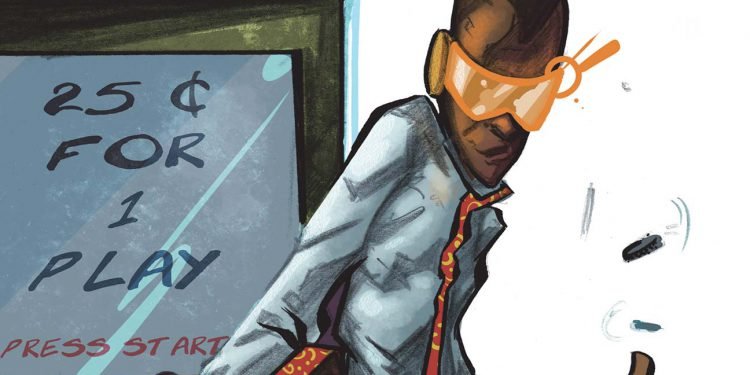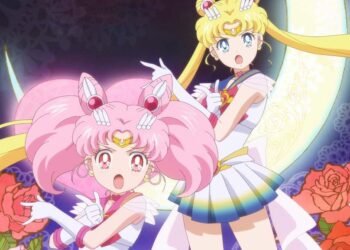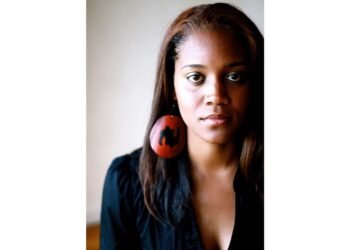Joining Ayala and Lore on the series are artist Jamie Jones (Joey Ryan: Big in Japan, Puerto Rico Strong) and letterer/designer Ryan Ferrier, who together draw on very specific parts of the past to create a complete vision of the future that nods to cyberpunk and classic SF, as well as hip-hop and video game cultures, as can be seen in the preview below.
Jones, Lore and Ayala talked to THR about the series.
Quarter Killer feels like multiple comics in one, in the best way; it’s something that is wonderfully complex, without feeling overly complicated. For a world that feels not only complete, but also as if it’s always existed, I’m curious: What and where were the origins of the book? Where did Quentin come from?
Vita Ayala: One of the most fundamental parts of Danny and my friendship is riffing creatively. It’s like freestyling, but with storytelling. This has been the case from the beginning.
QK as a general concept came very early in our friendship — almost 10 years ago now — when we were talking about some of our favorite cyberpunk stories and going “but what if it was New York and black?” We are both huge fans of the genre overall, and the idea of digital espionage and fighting corporations with their own tools.
The idea of the hacker as a lone cowboy type is pretty standard, and so the spin is that, no, what if they were doing it for the culture? Why wouldn’t a hacker use their skills to help their community? That is such a big part of who Danny and I are, and we wanted to bring that to a genre we love.
Danny Lore: QK mostly originates in the fact that we’re a big group of nerds, but like, cool nerds — well, the rest of the team is cool. QK was literally us riffing in the comic shop like “yo, what if there was this dude… and they took mercenary jobs… but it’s the future, so they take quarters because they can play games and call their mama.” Over time, [Quentin] became a real character, and we started to populate the world around them. Some of the character concepts were just joke concepts to start and then they took on lives of their own. And that’s especially true once Jamie started doing concepts.
Jamie Jones: When taking on the look of the book, something we all thought a lot about is how NYC would look in the not-too-distant future. What this means from my end is taking trends that are happening now and making them bigger or taking fashion trends from the past and bringing them back to light. Hip-Hop fashion of the ’80s plays a big part in the way people dress in our future. So the work comes in making these “dated” trends and uncomfortable fabrics work for future fashion. One of the ways I approached that was by giving characters a distinct print. A pattern that could be pasted in the lining of jackets or shirts that would make the world feel vibrant in a pretty bleak setting.
Vita, you alluded to this already, but the book feels like a purposeful response to the fact that so much sci-fi — and especially the cyberpunk-esque space that this feels like it fits into — is, well, filled with cis white dudes frowning a lot. This is more colorful, and for all the retro touches, feels far more like the future. Am I reading too much into that?
Ayala: I grew up on sci-fi, both hard and more gentle, gritty and shiny. It was my first love as a genre, and will always be where I return to.
That being said, a lot of what I do when given the choice, is to try and be in conversation with what is lacking (or what there is not as much of). I write for younger versions of myself, to try and give them what they didn’t have when they needed it, and for future versions of myself, to look back on and feel seen.
And I also want to write for folks that are nothing like me to see folks like me — I lost count of how many people I was a “first” (black friend, queer friend, non-binary friend, etc) for. A large part of empathy is exposure to different folks in ways that humanize them, and that has always been a goal for me — to engender empathy so that younger folks coming up have less nonsense to deal with.
Also, yes, there is a lot of Serious and Frowny sci-fi, and I want to help add to the fun and slick corner of the genre! You can have things to say and still make jokes and be more light hearted, absolutely.
Lore: So what’s always been important to me is that the underpinnings of cyberpunk have always been brown and queer! Transhumanism is about technology and its relationship to the body and how one changes the other, right? In the same vein, cyberpunk has always been about marginalized people under the shadow of those in power, and how they survive, fight, and game the system. While a lot of the stories that made it big in the supposed canon feel very cis white dude, but we’ve always existed as part of the structure and heart of the genre.
I think what makes even the retro touches feel futuristic is that it’s not simply a future that we made brown and queer. It’s our future, it’s the future of the people that Vita and I grew up around, that we become, and how those communities react to what comes next.
Jones: Diversity is something that I really wanted to translate in the world around QK. I spent a few weeks prior to working on the book just coming up with a color palette that I could always go back to. Finding colors that worked well together under different lighting. Running through the middle of the palette is a progression of skin tones varying from very dark almost usability so to very white also unusable. This helps me just pick different colors from background characters and constantly being varied.
Appropriately for this kind of story, there’s a more going on that meets the eye in this first issue — which is saying something, considering how great the visuals of the book are, but we’ll come back to that in a second. Yet, despite the plot twists and reveals, each character feels very clear and immediate. How did you go about making Quentin and Aya so complete so quickly? Within their first interaction, the reader is left knowing who they are and what they’re about — or is that a sneaky double bluff on your parts?
Lore: Quarter Killer and Aya’s meeting is quick, but, to be honest, it was years in the making for all of us, and I think it’d be disingenuous to discount that. Part of the clarity of that opener comes from us having known the characters for as long as we have. It’s much easier to write that opener once you’ve got a good grasp for who they are. As for double bluffs — we’ve got plenty of those, but we’re not going to let you in on our tells!
Ayala: For me, I wanted to find a way to make them tangible quickly in the way that when you first meet someone at a party, you don’t necessarily know a person’s entire history but you get a sense of them as an entity. I thought a lot about first introductions to folks, and more, about introducing two people I know very well to each other. What does that look and feel like?
A lot of it has to do with dynamics — everyone has their needs, wants, and dislikes, how do those interact? Because Danny, Jamie and I have been living with these characters for a long time; we know them well and we know how their edges will fit together. I am glad they feel complete, because to us, they are — we know almost everything about them, and so the trick is to find a way to NOT put it all in one scene, but to give enough while hinting at the hidden parts.
Jones: Posture is everything! Just little head tilts or leans can translate entire personality traits to characters.
Quarter Killer is a comic that, it feels, is perfect for something like ComiXology Originals — a comic that speaks to a mainstream audience that might not go to comic stores, but will instantly understand the references and worldview of the book. When you’re working with a publisher like ComiXology, do you feel a freedom to push what you can do, compared with something aimed at the direct market?
Ayala: There are different, not less though, considerations for the digital model, but I think not having to think about physical production and distribution gives us a chance to show what we can do without stressing out a longer chain of people who have to consider things like the overhead of a store. Having worked comics retail for a while, I sympathize and respect the balancing act!
The folks over at ComiXology have been incredibly supportive of us doing our thing. I think part of it is the medium and the story, absolutely — and yes, a cyberpunk book that is digital definitely has a nice flavor to it — but I think part of it is that they are confident of us as a team.
Lore: ComiXology really allowed us a lot of freedom, and that means that we’re telling the exact story that we set out to tell. In a way, for me, doing QK for ComiXology feels like the first time I got an E-reader: the very first thing I ever did was buy Neuromancer by William Gibson and load it up. It feels different to engage with that story in the digital world, and I think we wanted to tell a story that was very specifically made to be about the future, and engaged with on a platform that reflects one of the many futures of the medium.
Let’s talk about the art for a second. Jamie’s artwork, and Ryan’s letters and design, feel like they’re completely in sync, and completely immersive. They’re sharing influences and aesthetics, and the result is something unlike any other comic out there right now. How much of this was in the script, and how much is the two of you simply going, “Oh, wow, oh, yes, that”?
Ayala: The fun thing about working with Jamie and Ryan is that they are both friends of ours, and so we get to talk about all that stuff before Danny and I script. Part of it is Danny and I riffing and Jamie and Ryan taking that and making magic, but as important and often, it is Jamie going, “Wait, what about this” or Ryan tinkering and sending files, and Danny and I screaming, “Hell to the yeah!” and blasting victory music.
There is always new stuff we add in the script stage, absolutely, but Jamie then goes, “Yo, I did that, but also I was studying X, or this reminded me of Y, and I did a remix.”
Danny and I have a vibe that is fundamentally important for this book, and Jamie and Ryan bring their experience, expertise and all sorts of ideas to the table and we get the best of it all — something better than the sum of its parts.
Lore: Every day, Jamie sends us pages — hell, even straight-up layouts — it’s us going, “Oh, wow, oh, yes, that.” We give references sometimes, describe things, but I think Vita and I both subscribe to the idea that panel descriptions aren’t the be all and end all. They’re a conversation with the artist, sometimes a jumping off point to something that’s cooler and wilder than we could have conceived. There are plot points in the latter half of the series that exist because we saw what Jamie did in the first two issues and played off of that — the words are as shaped by the art as it is the other way around.
And Ryan is a lettering and design beast. We would toss out inspirations, and he’d hit us back with work that just blew our minds regularly. Every SFX placement, the shapes of every sound, it really brings the whole book together and is one of the best representations of our goals and aesthetic that show up, I think.
Jones: Ryan and I have worked together in the past. He is one of my favorite letterers in the biz now. You can suggest something and he comes back with a look for the book that is better than you were expecting. Speaking for myself, I come with a lot of old comics influence. One of the greatest is Eisner and the Spirit. I can’t escape it. There are places in the script where Vita or Danny will add some hyperlinks to give me a reference to a specific NYC thing that they grew up with and other times when they just let me do my thing. The three of us talked a lot about what the book should look like before we started the project proper. So during the actual page production it’s pretty much me just trying in pages.
Here’s an obvious place to end: How do you introduce Quarter Killer to a new audience? What would you say to the curious THR reader who’s about to read the preview and thinking about picking the series up?
Ayala: I think that there are a lot of points of entry to this book. It is visually stunning and kinetic/dynamic. The line work, the colors, the energy of it is off the charts! The design and lettering is so slick and clean and fun — master-level work that makes you just fall into the story.
The story is universal while still being so very New York. It is about community, about redemption, about the struggle between those with and those without. But it is also very rooted in hip-hop, in city culture, in the experience of people who know all the best spots to avoid a camera so they can play unharnessed and know that the bodega brand icee is as good as the fancy ones that come with their own spoon.
This is Robin Hood meets Neuromancer, Lone Wolf & Cub meets Snow Crash. If you like any of that, you’ll do just fine with Quarter Killer.
Lore: Normally, when I pitch QK to a reader, I like to phrase it as Lone Wolf and Cub meets Shadowrun. It’s a cyberpunk near-future that’s as queer and as brown as the world around us. It’s a book for people who are looking for a vibrant adventure story in which the characters are empowered to change the world around them — and get to look so fresh while doing it!
Quarter Killer No. 1 will be released Wednesday on ComiXology, and available for no additional charge for Amazon Prime, Kindle Unlimited and Comixology Unlimited members.

















































